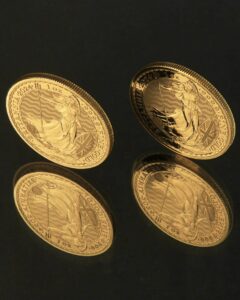The story of British gold coins is one filled with kings, conquests, and centuries of change. From medieval monarchs to modern investors, these coins have played a fascinating role in shaping both the nation’s economy and its identity. What started as royal experimentation has become a living legacy that still carries value—both monetary and historical—today. Let 1OZ Gold Britannia do the honor of explaining to you.

It all began in 1344, during the reign of King Edward III, with the introduction of the gold florin. Unfortunately, this early attempt at gold currency didn’t take off. The coin’s face value didn’t match its gold content, leading to its quick withdrawal. Still, the monarchy wasn’t discouraged. Soon after, the gold noble was introduced—a sturdier and more successful coin, weighing just under 7 grams of gold. Trade blossomed with this new currency, and the angel coin followed, making its way into folklore as well as everyday transactions.
Fast forward to the Tudor era, and the landscape of British coinage shifted again. In 1489, Henry VII introduced the gold sovereign. Larger and heavier than earlier coins, it wasn’t just currency—it was a statement. The sovereign quickly gained prestige and stayed in circulation for centuries, even after political shifts and royal transitions. Its reputation spread far beyond Britain, anchoring global trust in British currency and helping to fuel international trade and finance.
The 19th century brought another major shift: the Great Recoinage. Backed by the Bank of England, this initiative modernized British coinage, refining the sovereign into a smaller yet equally influential form. By then, the gold sovereign wasn’t just a national coin—it had become a global symbol of reliability. From Sydney to Cape Town, walking into a bank and placing a sovereign on the counter meant you’d be taken seriously.
During the two World Wars, the use of gold coins declined. Wartime economies leaned on paper money and base-metal coinage, and physical gold became scarce in public hands. Still, the sovereign endured. It moved from circulation into the hands of collectors and investors, becoming a treasured keepsake and a reliable asset. Mints continued to strike sovereigns in special editions, keeping the tradition alive even in changing times.
In the late 20th century, Britain reasserted its presence in the bullion market with the introduction of the Gold Britannia coin. This coin combined the rich symbolism of British heritage with modern precision. With high gold purity and intricate designs, the Britannia proved that British coins weren’t just about the past—they were a part of the future too.
Today, British gold coins remain a living connection between history and modern investing. Whether you’re holding a centuries-old sovereign or a freshly minted Britannia, you’re carrying more than just gold—you’re holding a piece of a story that spans generations. In every shine and stamp, there’s legacy, craftsmanship, and a quiet nod to a nation’s evolving place in the world.